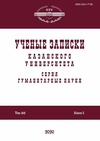Названия смешанных мастей лошади в башкирском языке: генезис, развитие и семантика
Names of horse coat colors in the Bashkir language: Genesis, development, and semantics
Author(s): Rimma Talgatovna MuratovaSubject(s): Lexis, Semantics, Historical Linguistics, Comparative Linguistics, Turkic languages
Published by: Казанский (Приволжский) федеральный университет
Keywords: names of horse coat colors; Bashkir language; Turkic languages;
Summary/Abstract: The names of mixed horse coat colors in the Bashkir language were analyzed in etymological, comparative-historical, and lexical-semantic aspects. Based on the results of the analysis, the following color names were identified as the most common ones: qola ‘dun’, saptar ‘skewbald’, burtä ‘dark bay’, turï ‘bay’, burїl ‘roan’, kir ‘bay with yellowish markings’, buð/kük ‘gray’, ala ‘piebald’, sïbar ‘motley’. The above color names are mainly independent lexemes meaning exclusively the colors of horse coats (except for buð, kük, ala, sïbar). The lexemes qola, turï, buð, kük, ala, and sїbar go back to the ProtoTurkic language. The color names burïl, saptar, and kir are the Mongolian borrowings. The word bürtӓ is confined to a particular geographic area. The names qola, turï, buð, ala, and sїbar were detected in the ancient Turkic written monuments, which confirms their long history of active use in the language of the Turks.
Journal: Ученые записки Казанского университета. Серия Гуманитарные науки
- Issue Year: 163/2021
- Issue No: 1
- Page Range: 19-29
- Page Count: 11
- Language: Russian

